Vicarious Liability: Doctrine, Examples, and Insurance Implications
VerifiedAdded on 2020/04/21
|7
|1561
|302
Report
AI Summary
This report provides an in-depth analysis of vicarious liability, a legal doctrine that assigns liability for a tortious act to a party who did not directly cause the injury but has a legal relationship with the negligent party. The report explores various examples of such relationships, including employer-employee, parent-child, and vehicle owner-driver scenarios. It discusses the principles under which vicarious liability is applied, emphasizing fairness, convenience, and the concept of joint liability. The report highlights the role of vicarious liability in loss distribution and the implications of insurance coverage, with a specific focus on medical malpractice cases. It also delves into the conditions necessary for establishing vicarious liability, such as the employer's control over the employee's actions, and provides relevant case examples. Finally, the report concludes with a summary of the doctrine's modern applications and the conditions for its admissibility, along with a list of cited references.
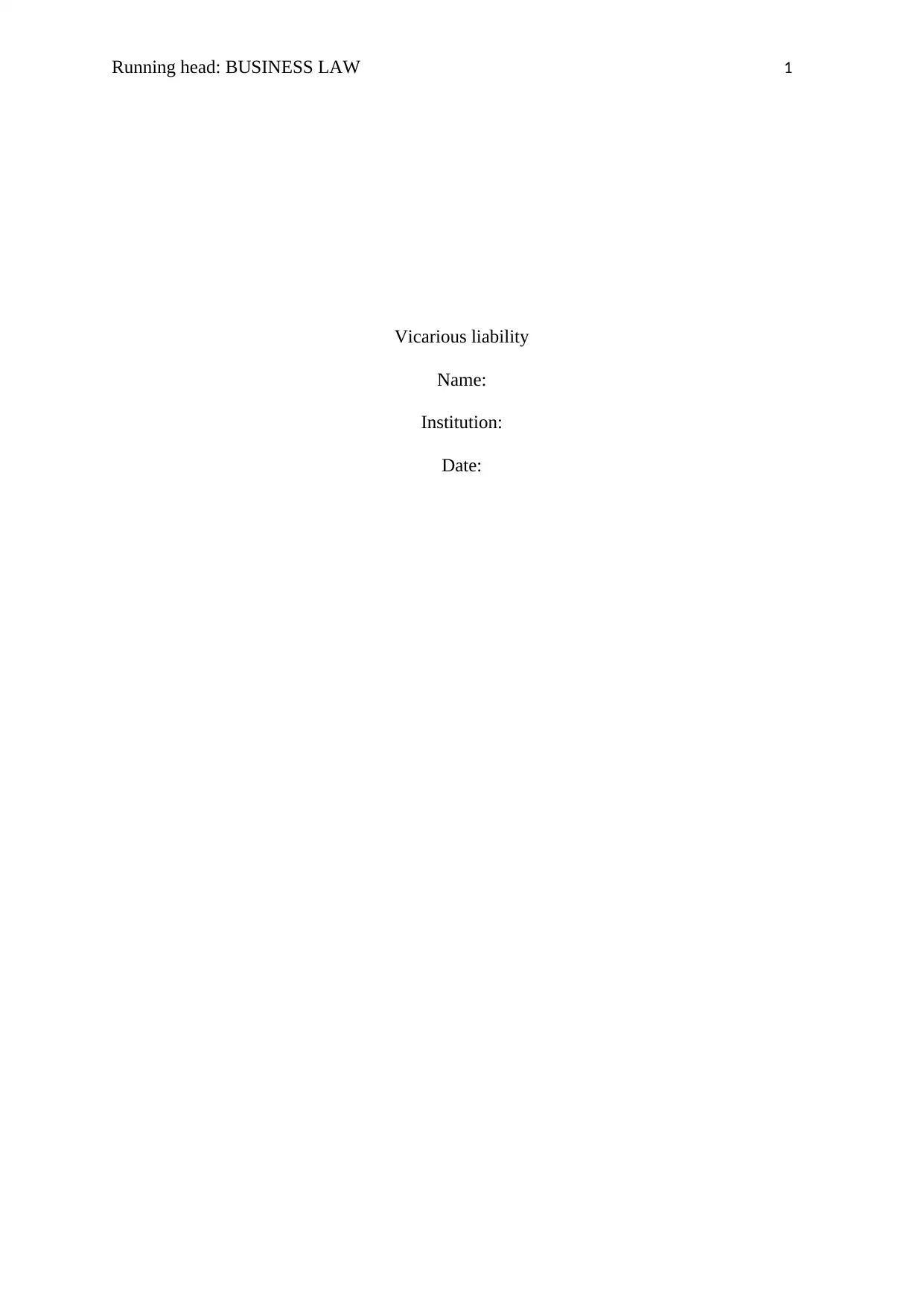
Running head: BUSINESS LAW 1
Vicarious liability
Name:
Institution:
Date:
Vicarious liability
Name:
Institution:
Date:
Paraphrase This Document
Need a fresh take? Get an instant paraphrase of this document with our AI Paraphraser
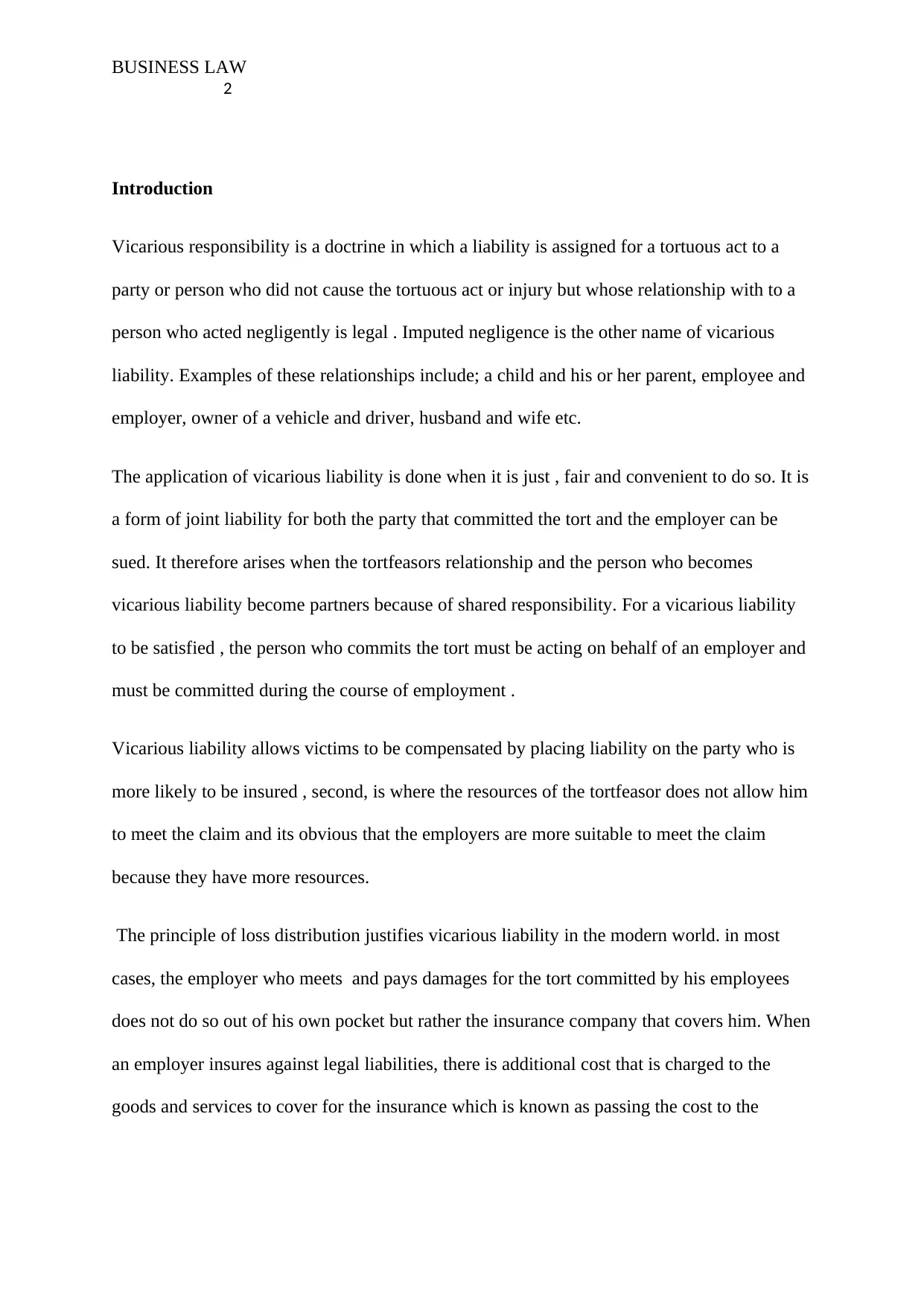
BUSINESS LAW
2
Introduction
Vicarious responsibility is a doctrine in which a liability is assigned for a tortuous act to a
party or person who did not cause the tortuous act or injury but whose relationship with to a
person who acted negligently is legal . Imputed negligence is the other name of vicarious
liability. Examples of these relationships include; a child and his or her parent, employee and
employer, owner of a vehicle and driver, husband and wife etc.
The application of vicarious liability is done when it is just , fair and convenient to do so. It is
a form of joint liability for both the party that committed the tort and the employer can be
sued. It therefore arises when the tortfeasors relationship and the person who becomes
vicarious liability become partners because of shared responsibility. For a vicarious liability
to be satisfied , the person who commits the tort must be acting on behalf of an employer and
must be committed during the course of employment .
Vicarious liability allows victims to be compensated by placing liability on the party who is
more likely to be insured , second, is where the resources of the tortfeasor does not allow him
to meet the claim and its obvious that the employers are more suitable to meet the claim
because they have more resources.
The principle of loss distribution justifies vicarious liability in the modern world. in most
cases, the employer who meets and pays damages for the tort committed by his employees
does not do so out of his own pocket but rather the insurance company that covers him. When
an employer insures against legal liabilities, there is additional cost that is charged to the
goods and services to cover for the insurance which is known as passing the cost to the
2
Introduction
Vicarious responsibility is a doctrine in which a liability is assigned for a tortuous act to a
party or person who did not cause the tortuous act or injury but whose relationship with to a
person who acted negligently is legal . Imputed negligence is the other name of vicarious
liability. Examples of these relationships include; a child and his or her parent, employee and
employer, owner of a vehicle and driver, husband and wife etc.
The application of vicarious liability is done when it is just , fair and convenient to do so. It is
a form of joint liability for both the party that committed the tort and the employer can be
sued. It therefore arises when the tortfeasors relationship and the person who becomes
vicarious liability become partners because of shared responsibility. For a vicarious liability
to be satisfied , the person who commits the tort must be acting on behalf of an employer and
must be committed during the course of employment .
Vicarious liability allows victims to be compensated by placing liability on the party who is
more likely to be insured , second, is where the resources of the tortfeasor does not allow him
to meet the claim and its obvious that the employers are more suitable to meet the claim
because they have more resources.
The principle of loss distribution justifies vicarious liability in the modern world. in most
cases, the employer who meets and pays damages for the tort committed by his employees
does not do so out of his own pocket but rather the insurance company that covers him. When
an employer insures against legal liabilities, there is additional cost that is charged to the
goods and services to cover for the insurance which is known as passing the cost to the
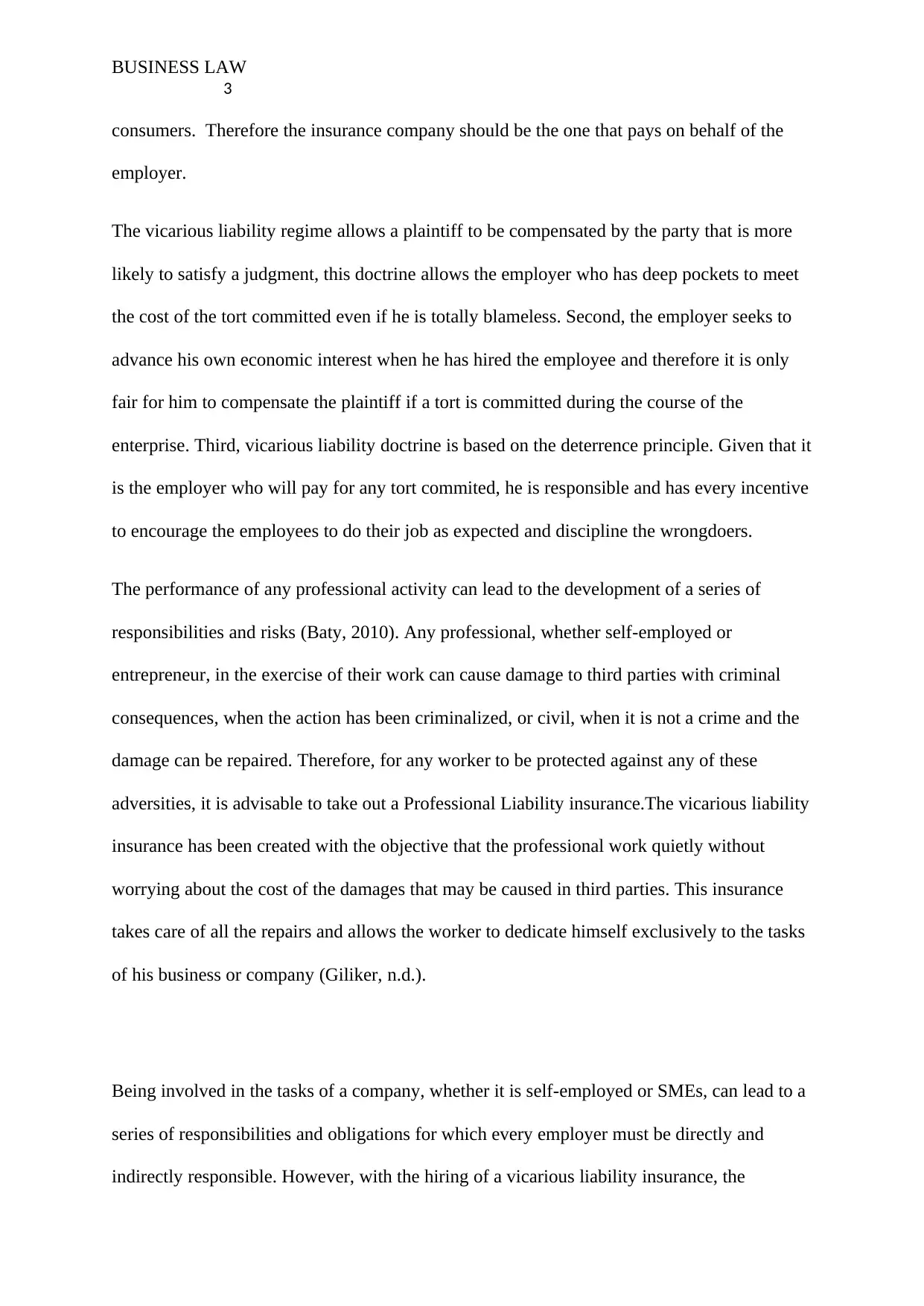
BUSINESS LAW
3
consumers. Therefore the insurance company should be the one that pays on behalf of the
employer.
The vicarious liability regime allows a plaintiff to be compensated by the party that is more
likely to satisfy a judgment, this doctrine allows the employer who has deep pockets to meet
the cost of the tort committed even if he is totally blameless. Second, the employer seeks to
advance his own economic interest when he has hired the employee and therefore it is only
fair for him to compensate the plaintiff if a tort is committed during the course of the
enterprise. Third, vicarious liability doctrine is based on the deterrence principle. Given that it
is the employer who will pay for any tort commited, he is responsible and has every incentive
to encourage the employees to do their job as expected and discipline the wrongdoers.
The performance of any professional activity can lead to the development of a series of
responsibilities and risks (Baty, 2010). Any professional, whether self-employed or
entrepreneur, in the exercise of their work can cause damage to third parties with criminal
consequences, when the action has been criminalized, or civil, when it is not a crime and the
damage can be repaired. Therefore, for any worker to be protected against any of these
adversities, it is advisable to take out a Professional Liability insurance.The vicarious liability
insurance has been created with the objective that the professional work quietly without
worrying about the cost of the damages that may be caused in third parties. This insurance
takes care of all the repairs and allows the worker to dedicate himself exclusively to the tasks
of his business or company (Giliker, n.d.).
Being involved in the tasks of a company, whether it is self-employed or SMEs, can lead to a
series of responsibilities and obligations for which every employer must be directly and
indirectly responsible. However, with the hiring of a vicarious liability insurance, the
3
consumers. Therefore the insurance company should be the one that pays on behalf of the
employer.
The vicarious liability regime allows a plaintiff to be compensated by the party that is more
likely to satisfy a judgment, this doctrine allows the employer who has deep pockets to meet
the cost of the tort committed even if he is totally blameless. Second, the employer seeks to
advance his own economic interest when he has hired the employee and therefore it is only
fair for him to compensate the plaintiff if a tort is committed during the course of the
enterprise. Third, vicarious liability doctrine is based on the deterrence principle. Given that it
is the employer who will pay for any tort commited, he is responsible and has every incentive
to encourage the employees to do their job as expected and discipline the wrongdoers.
The performance of any professional activity can lead to the development of a series of
responsibilities and risks (Baty, 2010). Any professional, whether self-employed or
entrepreneur, in the exercise of their work can cause damage to third parties with criminal
consequences, when the action has been criminalized, or civil, when it is not a crime and the
damage can be repaired. Therefore, for any worker to be protected against any of these
adversities, it is advisable to take out a Professional Liability insurance.The vicarious liability
insurance has been created with the objective that the professional work quietly without
worrying about the cost of the damages that may be caused in third parties. This insurance
takes care of all the repairs and allows the worker to dedicate himself exclusively to the tasks
of his business or company (Giliker, n.d.).
Being involved in the tasks of a company, whether it is self-employed or SMEs, can lead to a
series of responsibilities and obligations for which every employer must be directly and
indirectly responsible. However, with the hiring of a vicarious liability insurance, the
⊘ This is a preview!⊘
Do you want full access?
Subscribe today to unlock all pages.

Trusted by 1+ million students worldwide
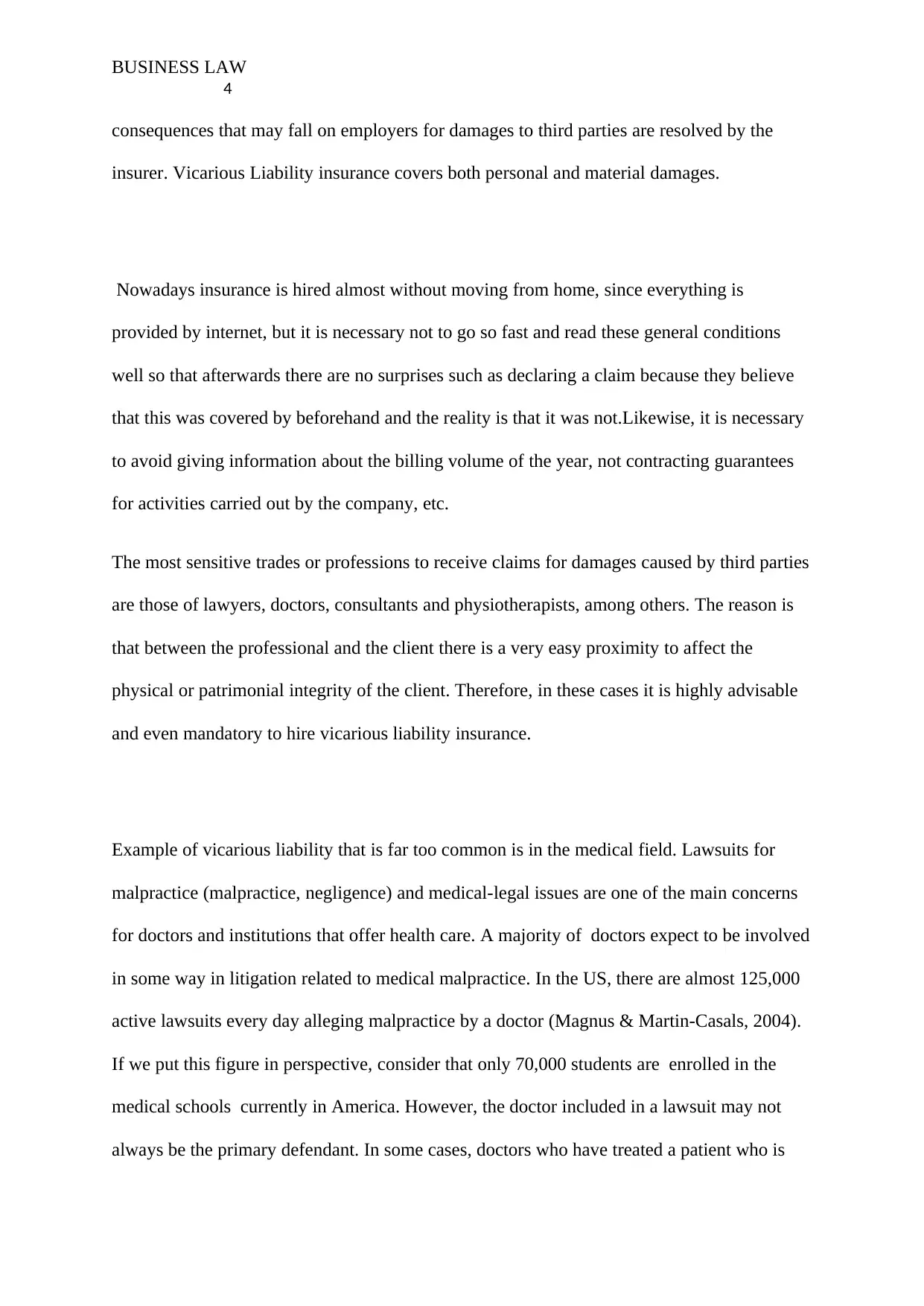
BUSINESS LAW
4
consequences that may fall on employers for damages to third parties are resolved by the
insurer. Vicarious Liability insurance covers both personal and material damages.
Nowadays insurance is hired almost without moving from home, since everything is
provided by internet, but it is necessary not to go so fast and read these general conditions
well so that afterwards there are no surprises such as declaring a claim because they believe
that this was covered by beforehand and the reality is that it was not.Likewise, it is necessary
to avoid giving information about the billing volume of the year, not contracting guarantees
for activities carried out by the company, etc.
The most sensitive trades or professions to receive claims for damages caused by third parties
are those of lawyers, doctors, consultants and physiotherapists, among others. The reason is
that between the professional and the client there is a very easy proximity to affect the
physical or patrimonial integrity of the client. Therefore, in these cases it is highly advisable
and even mandatory to hire vicarious liability insurance.
Example of vicarious liability that is far too common is in the medical field. Lawsuits for
malpractice (malpractice, negligence) and medical-legal issues are one of the main concerns
for doctors and institutions that offer health care. A majority of doctors expect to be involved
in some way in litigation related to medical malpractice. In the US, there are almost 125,000
active lawsuits every day alleging malpractice by a doctor (Magnus & Martin-Casals, 2004).
If we put this figure in perspective, consider that only 70,000 students are enrolled in the
medical schools currently in America. However, the doctor included in a lawsuit may not
always be the primary defendant. In some cases, doctors who have treated a patient who is
4
consequences that may fall on employers for damages to third parties are resolved by the
insurer. Vicarious Liability insurance covers both personal and material damages.
Nowadays insurance is hired almost without moving from home, since everything is
provided by internet, but it is necessary not to go so fast and read these general conditions
well so that afterwards there are no surprises such as declaring a claim because they believe
that this was covered by beforehand and the reality is that it was not.Likewise, it is necessary
to avoid giving information about the billing volume of the year, not contracting guarantees
for activities carried out by the company, etc.
The most sensitive trades or professions to receive claims for damages caused by third parties
are those of lawyers, doctors, consultants and physiotherapists, among others. The reason is
that between the professional and the client there is a very easy proximity to affect the
physical or patrimonial integrity of the client. Therefore, in these cases it is highly advisable
and even mandatory to hire vicarious liability insurance.
Example of vicarious liability that is far too common is in the medical field. Lawsuits for
malpractice (malpractice, negligence) and medical-legal issues are one of the main concerns
for doctors and institutions that offer health care. A majority of doctors expect to be involved
in some way in litigation related to medical malpractice. In the US, there are almost 125,000
active lawsuits every day alleging malpractice by a doctor (Magnus & Martin-Casals, 2004).
If we put this figure in perspective, consider that only 70,000 students are enrolled in the
medical schools currently in America. However, the doctor included in a lawsuit may not
always be the primary defendant. In some cases, doctors who have treated a patient who is
Paraphrase This Document
Need a fresh take? Get an instant paraphrase of this document with our AI Paraphraser
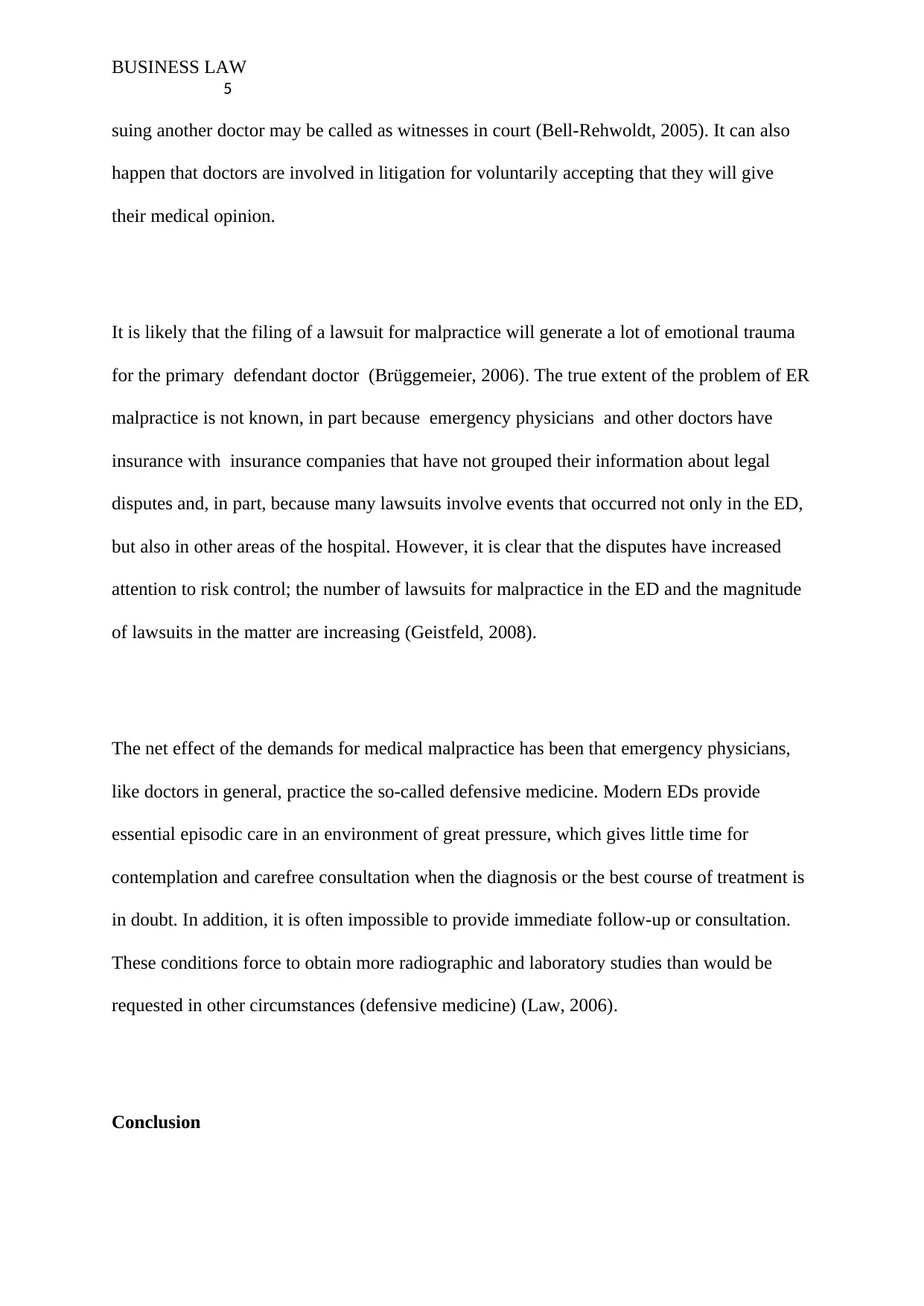
BUSINESS LAW
5
suing another doctor may be called as witnesses in court (Bell-Rehwoldt, 2005). It can also
happen that doctors are involved in litigation for voluntarily accepting that they will give
their medical opinion.
It is likely that the filing of a lawsuit for malpractice will generate a lot of emotional trauma
for the primary defendant doctor (Brüggemeier, 2006) . The true extent of the problem of ER
malpractice is not known, in part because emergency physicians and other doctors have
insurance with insurance companies that have not grouped their information about legal
disputes and, in part, because many lawsuits involve events that occurred not only in the ED,
but also in other areas of the hospital. However, it is clear that the disputes have increased
attention to risk control; the number of lawsuits for malpractice in the ED and the magnitude
of lawsuits in the matter are increasing (Geistfeld, 2008).
The net effect of the demands for medical malpractice has been that emergency physicians,
like doctors in general, practice the so-called defensive medicine. Modern EDs provide
essential episodic care in an environment of great pressure, which gives little time for
contemplation and carefree consultation when the diagnosis or the best course of treatment is
in doubt. In addition, it is often impossible to provide immediate follow-up or consultation.
These conditions force to obtain more radiographic and laboratory studies than would be
requested in other circumstances (defensive medicine) (Law, 2006).
Conclusion
5
suing another doctor may be called as witnesses in court (Bell-Rehwoldt, 2005). It can also
happen that doctors are involved in litigation for voluntarily accepting that they will give
their medical opinion.
It is likely that the filing of a lawsuit for malpractice will generate a lot of emotional trauma
for the primary defendant doctor (Brüggemeier, 2006) . The true extent of the problem of ER
malpractice is not known, in part because emergency physicians and other doctors have
insurance with insurance companies that have not grouped their information about legal
disputes and, in part, because many lawsuits involve events that occurred not only in the ED,
but also in other areas of the hospital. However, it is clear that the disputes have increased
attention to risk control; the number of lawsuits for malpractice in the ED and the magnitude
of lawsuits in the matter are increasing (Geistfeld, 2008).
The net effect of the demands for medical malpractice has been that emergency physicians,
like doctors in general, practice the so-called defensive medicine. Modern EDs provide
essential episodic care in an environment of great pressure, which gives little time for
contemplation and carefree consultation when the diagnosis or the best course of treatment is
in doubt. In addition, it is often impossible to provide immediate follow-up or consultation.
These conditions force to obtain more radiographic and laboratory studies than would be
requested in other circumstances (defensive medicine) (Law, 2006).
Conclusion
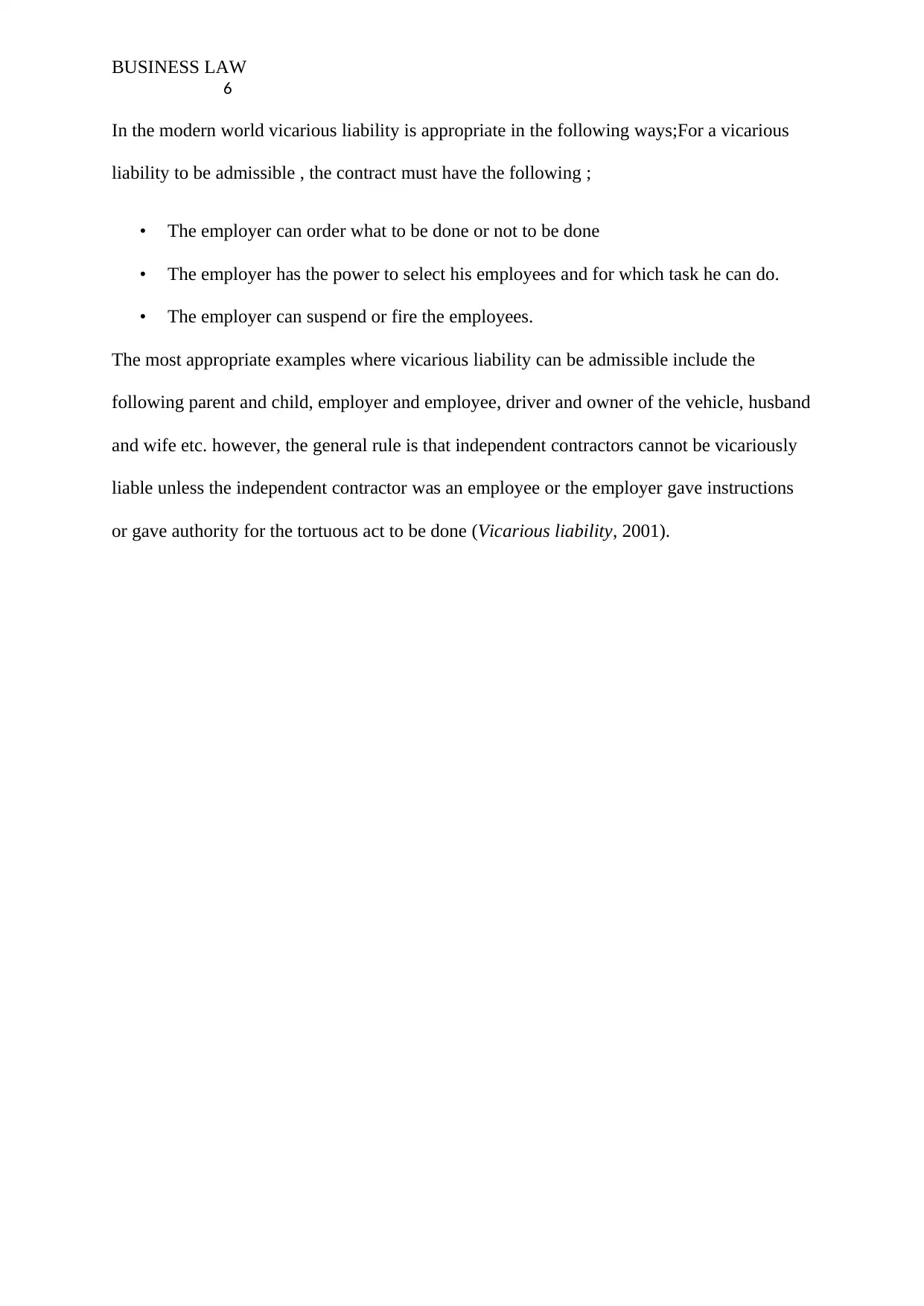
BUSINESS LAW
6
In the modern world vicarious liability is appropriate in the following ways;For a vicarious
liability to be admissible , the contract must have the following ;
• The employer can order what to be done or not to be done
• The employer has the power to select his employees and for which task he can do.
• The employer can suspend or fire the employees.
The most appropriate examples where vicarious liability can be admissible include the
following parent and child, employer and employee, driver and owner of the vehicle, husband
and wife etc. however, the general rule is that independent contractors cannot be vicariously
liable unless the independent contractor was an employee or the employer gave instructions
or gave authority for the tortuous act to be done (Vicarious liability, 2001).
6
In the modern world vicarious liability is appropriate in the following ways;For a vicarious
liability to be admissible , the contract must have the following ;
• The employer can order what to be done or not to be done
• The employer has the power to select his employees and for which task he can do.
• The employer can suspend or fire the employees.
The most appropriate examples where vicarious liability can be admissible include the
following parent and child, employer and employee, driver and owner of the vehicle, husband
and wife etc. however, the general rule is that independent contractors cannot be vicariously
liable unless the independent contractor was an employee or the employer gave instructions
or gave authority for the tortuous act to be done (Vicarious liability, 2001).
⊘ This is a preview!⊘
Do you want full access?
Subscribe today to unlock all pages.

Trusted by 1+ million students worldwide
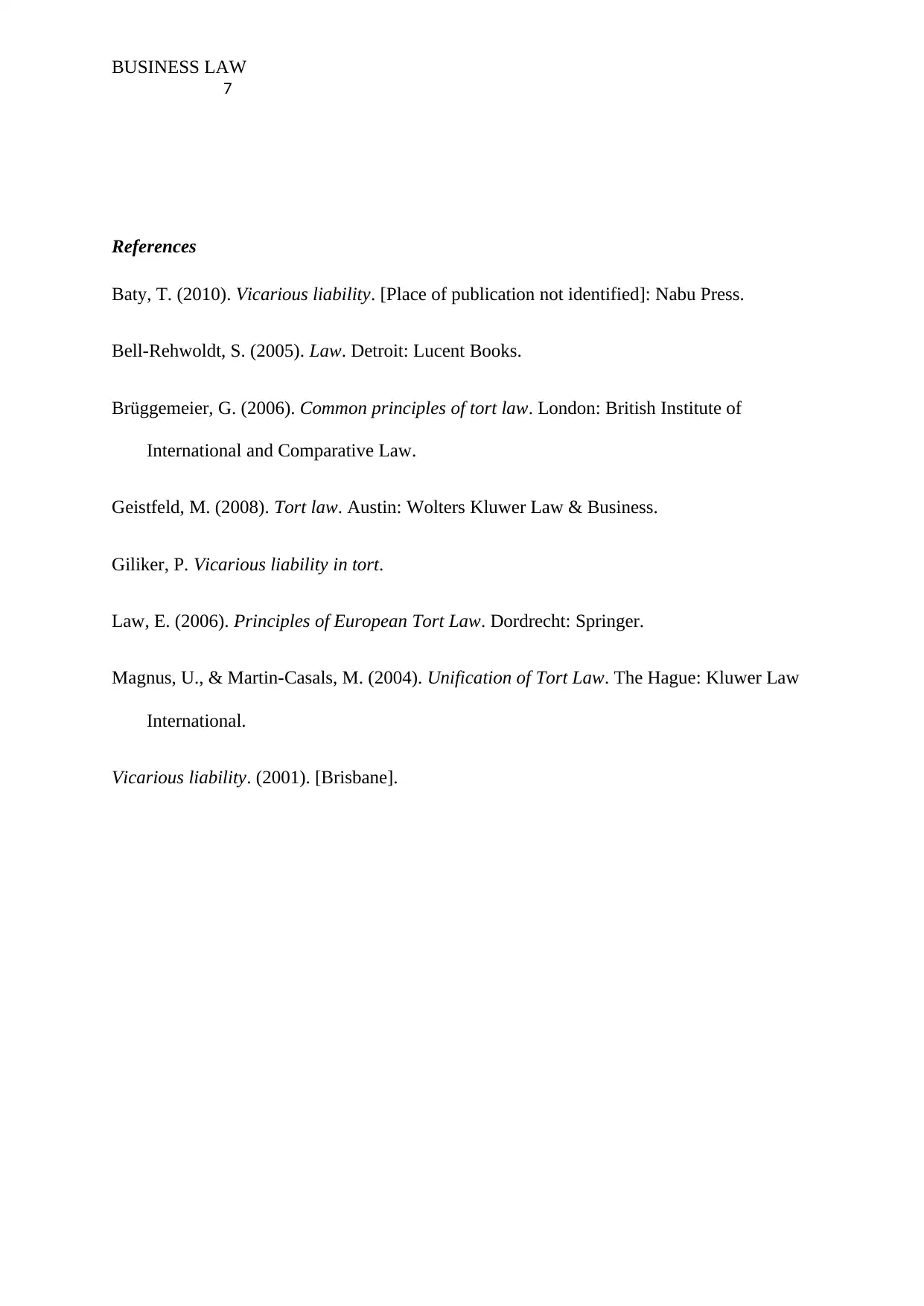
BUSINESS LAW
7
References
Baty, T. (2010). Vicarious liability. [Place of publication not identified]: Nabu Press.
Bell-Rehwoldt, S. (2005). Law. Detroit: Lucent Books.
Brüggemeier, G. (2006). Common principles of tort law. London: British Institute of
International and Comparative Law.
Geistfeld, M. (2008). Tort law. Austin: Wolters Kluwer Law & Business.
Giliker, P. Vicarious liability in tort.
Law, E. (2006). Principles of European Tort Law. Dordrecht: Springer.
Magnus, U., & Martin-Casals, M. (2004). Unification of Tort Law. The Hague: Kluwer Law
International.
Vicarious liability. (2001). [Brisbane].
7
References
Baty, T. (2010). Vicarious liability. [Place of publication not identified]: Nabu Press.
Bell-Rehwoldt, S. (2005). Law. Detroit: Lucent Books.
Brüggemeier, G. (2006). Common principles of tort law. London: British Institute of
International and Comparative Law.
Geistfeld, M. (2008). Tort law. Austin: Wolters Kluwer Law & Business.
Giliker, P. Vicarious liability in tort.
Law, E. (2006). Principles of European Tort Law. Dordrecht: Springer.
Magnus, U., & Martin-Casals, M. (2004). Unification of Tort Law. The Hague: Kluwer Law
International.
Vicarious liability. (2001). [Brisbane].
1 out of 7
Related Documents
Your All-in-One AI-Powered Toolkit for Academic Success.
+13062052269
info@desklib.com
Available 24*7 on WhatsApp / Email
![[object Object]](/_next/static/media/star-bottom.7253800d.svg)
Unlock your academic potential
Copyright © 2020–2025 A2Z Services. All Rights Reserved. Developed and managed by ZUCOL.





